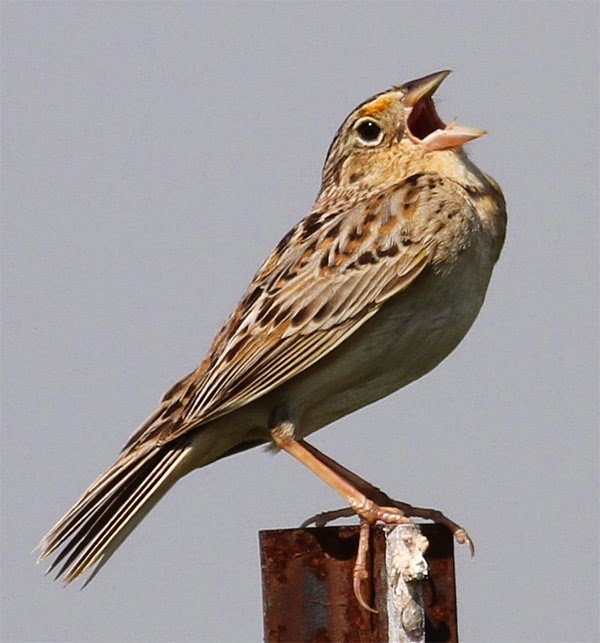 |
| The Carden Plain Information Sign |
The Carden Plain is designated an Important Bird Area due to the assemblage of species it supports, including the declining and rare Loggerhead Shrike, Grasshopper Sparrow and Eastern Bluebirds. The area also contains a rare habitat type known as the Alvar, which occurs where flat limestone bedrock is bare, or covered with a thin layer of soil. In such cases a distinctive flora and fauna is present.
 |
| View across part of Carden Plain |
There were essentially two reasons for me wanting to visit the area, the birds and the habitat. Bird wise I was hoping to see the rare Loggerhead Shrike, a new species for me, and also Upland Sandpipers, which breed here in good numbers. I had not really considered much else, but when I looked into the area in more detail I realised that there were a few other species that I had not previously seen, Grasshopper Sparrow, Vesper Sparrow and Eastern Whip-poor-will.
 |
| Ospreys - changing maternity duties |
Alvar Road was not what I expected habitat wise since it consisted of predominantly secondary woodland, either side of the road. The vegetation was dense and there was little to see from the car so I pressed onto the the intersection with Wylie Road. I had been advised by a friend that this was the best place to bird but had found it difficult to gain information on the area, and when asking local birders at Pelee and Rondeau, they appeared not to have heard of Carden Plain.
 |
| Female Eastern Bluebird - with a cricket species |
 |
| Female Eastern Bluebird |
Towards the southern end of Wylie Road there was an open expanse of plain, with scattered scrub and trees, and a sign which says The Windmill Ranch. There is an Eastern Bluebird box numbered 10 at this location, a small hide and a pull in so it can be easily found. I found this place to be the most reliable place to see Loggerhead Shrike and I stopped here on three occasions and each time I saw birds. On an evening visit to Wylie Road I saw three birds here, two to the north of the road and one to the south, which would suggest up to two breeding pairs being present. I noted that two of the birds were colour-ringed but in the heat haze I could not get the combinations.
 |
| Loggerhead Shrike - one of three seen |
As well as the shrikes there were Eastern Meadowlarks, Wild Turkeys, Song Sparrow, Eastern Phoebe, American Kestrel, Brown Thrasher, and on an evening visit amazing views of displaying Common Nighthawks. Be very careful in his area though, as the roadside verges can be dominated with poison ivy.
 |
| Brown Thrasher |
Upland Sandpipers could be heard calling along Wylie Road but the best views I had were midway between The Windmill Ranch and another Ranch known as Art’s Ranch to the north. At this point birds would come into a very large puddle on the road to bathe. The vegetation in the field immediately adjacent and to the south of the road was short and close views could be had. Of course scanning any field, especially the rocks would often produce a bird, but these were more distant.
 |
| Upland Sandpiper |
 |
| Upland Sandpiper |
 |
| Upland Sandpiper |
Whilst watching the sandpiper’s a Red-headed Woodpecker appeared. This bird was feeding low down on the trunk of a small roadside tree and gave excellent views. Apparently this species in now rare in the area, but I saw the species on two occasions in the area, and also an Eastern Towhee which was an unexpected bonus.
 |
| Red-headed Woodpecker - a rare bird on Carden Plain |
Art’s Ranch is also apparently known as the sparrow field by the local birders since it lacks trees and therefore is the best place to see them. Grasshopper Sparrow is one of the specialities to be seen here, and can be readily seen singing from a favoured song post, usually one of the road side fence posts. I only saw the one male bird, but true to form he sang from the same song perch every time and gave excellent views.
 |
| Grasshopper Sparrow |
 |
| Grasshopper Sparrow |
Other sparrow species recorded were Savannah, Song and Field, the latter being another difficult species to connect with these days apparently.
 |
| Field Sparrow |
 |
| Savannah Sparrow |
Sedge Wren Marsh Trail is one of the areas where you can venture off the road. I walked part of the trail on two occasions, once during the day when the highlights I recorded were Red-eyed Vireo, American Redstart, Common Yellowthroat and Cedar Waxwing, and once at dusk when I recorded Common Nighthawk and at least three Eastern Whip-poor-wills. Unfortunately I did not see the whip-poor-will but could hear its distinctive song further along the trail.
No comments:
Post a Comment